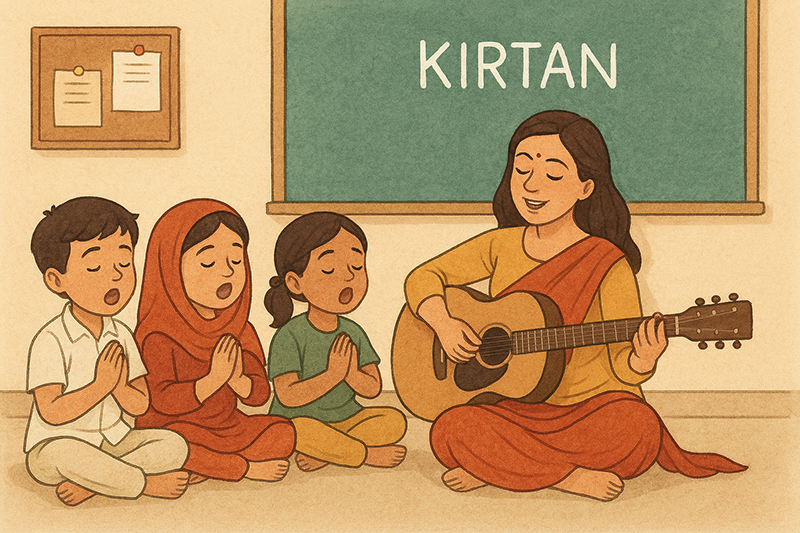By MahaJyoti Glassman
What is Kiirtan
The practice of kiirtan is simple repetitive chanting for 2-5 minutes or more. This method of rhythmic singing is called kiirtan. Singing kiirtan supports kids in preparing their minds and bodies for meditation by engaging the sensory organs (eyes, ears, touch) and motor organs (arms and legs) towards the Goal.
The power of mantra, a collection of sacred sounds, is its ability to rhythmically blend the rhythm of the breath with sound. Some mantras, such as Baba Nam Kevalam, may be sung aloud. This mantra carries with it the feeling of benevolent love for all created beings. Singing mantra or affirmations such as “I am a Super Friend” generates positive energy and joy within the minds and hearts of children.
Culture and Mantra
Singing mantras is a practice found in many cultures. However, there are some public settings such as schools or community centers where chanting in Sanskrit may not be culturally appropriate. In these situations, the group may sing a local translation such as ‘Love is all there is’, ‘Love is everywhere’ or an affirmation such as “I am Love”or “I am a Super Friend”) can be practiced. These generate positive energy, joy, and connection with kids when they can feel the meaning in their hearts.
The 3 R’s and Benefits of Kiirtan
Because of this unique combination of ‘rhyme, rhythm, and repetition’ in kiirtan, clinical studies have shown there are many beneficial effects for the brain while calming the nervous system. The combined power of the 3 R’s is deeply engaging, capturing and sustaining their attention.
Additional benefits include:
- Minimizing the effects of inferiority, superiority, and defeatism
- Diminishing depression, fear, anxiety, and stress
- Uplifting the emotional mood and calming the mind
- Lessening negative thought patterns such as defective thinking and negativity
- Improving attention and behavior
- Enhancing joyfulness, contentment, positivity, and peace
- Deepening one’s sense of connection with the Divine, the creation, and all beings
How is it Sung
Kiirtan can be sung in a monotone or to a simple tune that is age appropriate for the students. In preschool, familiar songs such as nursery rhymes can be adapted to Baba Nam Kevalam singing. Simple melodies yield the best results for the young child. Older student may enjoy more complex tunes. They may explore the call response style in which the teacher or a lead student may sing one line at a time alone and the rest of the class responds in unison.
Teachers may also explore different volumes of singing: 1) Singing loudly, 2) Singing softly, 3) Whispering, 4) Silently, moving only the lips (no sound), and 5) Completely internal (for elementary kids).
Dancing and Movement
Children enjoy rhythmically dancing and moving their bodies. While singing kiirtan, they may love engaging their mouth, hands, feet, and body. They may stand, sit, dance, or jump – clapping their hands, their arms overhead, holding hands, flying, stomping, tiptoeing, or free form dancing. Moving in unison may be challenging for the very young child but can be performed by older elementary aged children. Playing instruments is great fun!
The Lalita Dance is a simple side-to-side rocking motion, tapping the toes of one foot behind the flat base foot This movement can also be difficult for the very young child (2-5 years). They can do whatever is comfortable, natural, and appropriate. Older ones should have no difficulty.
Dance forms may vary: 1) Moving in a circle, 2) Dancing in one spot, 3) Weaving in a single line (like a parade), or 4) Dancing out the door into the wide world. Let this practice be filled with fun!
A Feeling of Unity
Singing naturally requires deep breathing which relaxes the sympathetic nervous system through longer exhalations. When children sing together, they are breathing as one. This synchronicity creates a sense of harmony – moving, singing, and breathing together. Kiirtan becomes an experience of unity, a feeling of unconditional love.
Therapeutic Uses of Kiirtan
Physically, mentally, and emotionally – kiirtan practice is very soothing and joyful. Just five minutes of chanting can dissolve stress and negative emotions that are holding the child hostage. This can be performed individually with a teacher and child, or collectively (the whole class, sitting or standing) at any time of day. When children are experiencing sadness, frustration, or anger, kiirtan uplifts and refocuses their attention towards positivity.
Through kiirtan, children connect with the Inner Source and return to balance. This engages a feeling of oneness with The Great and sense of sharing kinship with all beings.
Baba Nam Kevalam – Let the kiirtan begin.
